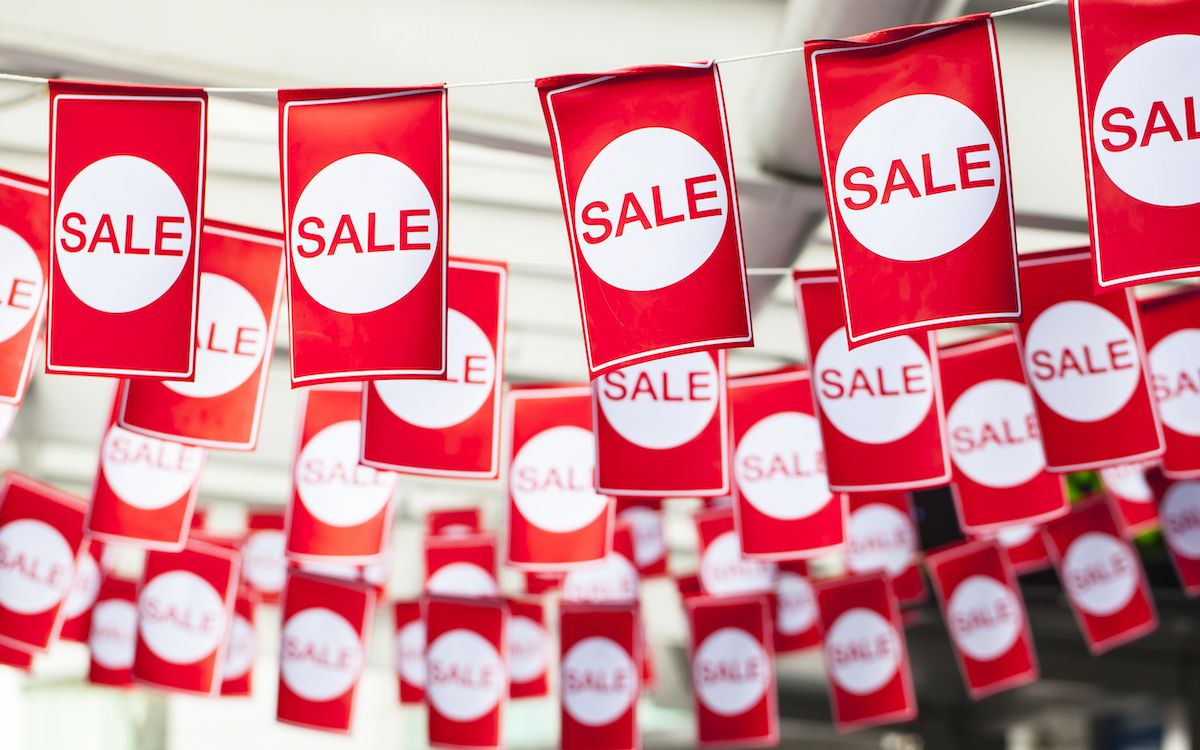
Everyone loves a sale—from the shoppers who get to save money on their purchases to the retailers who get to increase their number of sales as a result. Thankfully, there are a wide variety of tried-and-true ways to offer customers a deal that will make them feel more compelled to make a purchase. If you’re looking for the perfect type of sales promotions to offer your ecommerce customers, check out our list of the 15 most popular—from commonly used strategies to lesser-known tactics.
Best for: Almost anything, really
The most commonly used approach, dollar or percentage off deals simply offer products at a specific dollar amount or percent off of the regular listing price. This method can be applied to one-off products that your business is trying to move more inventory for, or on all products across one category (or your store as a whole). The advantage of offering this type of savings is that it gives customers a more straightforward idea of how much they will benefit, making them more likely to convert.
Best for: Products you want to get rid of; Products you want to raise awareness about
Buy One, Get One (sometimes referred to as BOGO) is another fairly straightforward way to show customers how much they will benefit from the deal being offered. The BOGO structure lets customers know that if they purchase two of the same item category (perhaps one for them and one for a friend), they’ll get a significant discount on the second item. Buy One, Get One Free is the most exciting option to offer, but if you can’t afford to offer what is essentially a 50% discount, Buy One, Get One 20-25% off can also be an enticing amount.
Best for: Items for which 50% off is too much; Items commonly bought in multiples
Tiered promotions are very similar to the Buy One, Get One concept, but require the purchase of more individual units to get the discount. For example, a business owner selling pairs of socks might offer “Buy 3, Get 1 Free,” which is essentially 25% off the purchase. (Unfortunately, BTGO doesn’t have as great of a ring to it as BOGO does.) This type of promotion is best for items that people generally will need or want multiples of at one time or over a period of time, like products that can be used up quickly.
Best for: Related products
Do any of the products you sell work well together (for example, a mixing bowl and an apron, or a mug and a tea infuser)? Bundling products like this together at a lower overall price can help you increase average order values by convincing shoppers to buy additional products they may not have been considering beforehand—or were considering from a competitor. This approach can be especially useful during gift-giving season, allowing customers to purchase a “complete experience” for their gift recipient in one place.
Best for: Product samples; New products; Inexpensive products you want to get rid of
Most people can’t resist getting something for free. Offering a free, inexpensive gift or sample with each purchase is a great way to raise awareness about the other products your ecommerce store offers while incentivizing a purchase in shoppers who may be on the fence. Your business could even go one step further by offering tiered free gifts to incentivize larger purchases—for example, book sellers might offer a free bookmark with a $25 purchase, free portable book light with a $50 purchase, and free fleece blanket with a $75 purchase.
Best for: Brands building a following
Not interested in giving away the products you’ve worked so hard on for free? If you have a great brand identity that you’re trying to bolster, consider offering free swag with each purchase. Providing something like stickers with your brand’s logo on it with each order for free can help bolster feelings of goodwill toward your brand—plus, should your customers use the free swag, it has the potential to contribute to word-of-mouth advertising.
Best for: Businesses that don’t offer this already
If you aren’t financially able to offer free shipping to customers on a regular basis, then this is a great route to take for one-off promotions. With mega brands like Amazon offering free shipping constantly, offering your customers that perk will put you on-par with them—even if it’s only for a short while. Although you may feel like you’re losing some revenue from shipping costs for the duration of the promotion, this is a great way to move new customers past a sticky point in the purchase process—and if they like what they receive enough, they’ll likely be willing to pay for shipping when they return to buy more.
8. Flash Sales
Best for: A quick boost in conversions
Nothing creates more urgency than learning you only have a certain amount of time to take advantage of a deal, which is what makes this type of sales promotion so successful. Flash sales involve letting customers know (via the site itself, email, and/or other quick advertising methods) that they can get a great deal, but only if they act now—think “today only” or “this weekend only.” Providing a discount for a very short duration gives customers less time to think about objections, as they’ll feel the need to take action and purchase immediately.
9. Giveaways
Best for: Brands building a following; Products you want more reviews for
Giveaways are another great way to take advantage of how much customers like receiving things for free—but in this case, you can set up the entry process so that your business gets something in return. For example, if you’re giving away a $100 store gift card, you could require customers who wish to be entered into the giveaway to fill out a feedback survey to provide valuable insights, like your pages or tagging their friends on social media to increase your following, or post user-generated content on social media to expand word-of-mouth advertising.
10. Competitions
Best for: Fun and social brands; Businesses looking for user-generated content
An excellent way to take advantage of the competitive spirit inherent to humans, competitions—like giveaways—allow you to ask your customers for something in return for the deal you’re giving them (a freebie, a gift card, a new product, etc.). Make sure the competitive event you choose is something fun, like finding Easter Eggs you’ve hidden throughout your blog or YouTube videos. This is another great opportunity to get some quality user-generated content; for example, you could have customers submit their best photo using your product(s) and have the public vote on the winner.
Best for: Brands starting or expanding a Loyalty program
Loyalty programs by themselves are a great way to get customers to purchase repeatedly. In addition to whatever constitutes the normal way of earning points for your loyalty program, consider structuring a deal around it—for example, “Purchase from our Fall collection this week and receive an extra 1,000 loyalty points—2,000 loyalty points earns you 20% off your next purchase.” The more you can get customers invested in your loyalty program, the more loyal to your brand they will become.
Best for: Brands starting or expanding a Referral program; Businesses looking to increase word-of-mouth advertising
Like loyalty programs, referral programs too are effective sales boosters, but in this case they contribute more to converting new customers. Aside from simply asking for referrals, build a deal into the program to reward both the referral (to get them to make their first purchase) and the re
feree (to reward them for bringing you a new potential customer). You can fold many of the above sales promotion types into this one; for example, “Refer a friend, get $5 off,” “Refer a friend for 500 loyalty points,” “Refer 5 friends by X date and receive a free gift,” etc. In terms of the referral, a simple dollar or percent off their first purchase should suffice.
13. Coupons & Codes
Best for: Advertising your products off-site
Customers who are not already on your site (ex: they find you through a Facebook ad, featured in a blog post, or another indirect way) could sometimes use an extra incentive to explore your online store sooner rather than later. And with a discount code or coupon burning a hole in their pocket, they are more likely to do so. Offering coupons and discount codes off-site lets customers know that they can save money before they even get there—and that they have a semi-exclusive way to do so that few other shoppers have.
14. Rebates
Best for: Wholesale retailers; High-ticket products
Rebates—or money paid back to a customer after a purchase—are a great way to offer a larger monetary reward for a large sale after the full payment has already been made. Popular types of rebates include Volume-based rebates, which are paid to the customer after they’ve purchased a certain number of products from you, and Year-End Rebates, which are paid out at the end of a year. Rebates are especially popular in the electronics and appliance industries, but can also be helpful for wholesalers to offer.
Best for: The world
Want to give back to the world in the process of making more sales? A charitable cause promotion is a perfect way for your business to do both at the same time. Simply let customers know that you will be setting aside a certain amount of the proceeds from the sales of one product, all orders in a 24-hour period, etc. for a charity—the feel-good aspect of the promotion will inspire more purchases. While you’re not giving back to customers the way you do with other promotions, you are giving back to the charity of your choice—and letting customers feel their own excitement about participating in that action.
Final Thoughts
Letting customers know that they will be rewarded for purchasing from your ecommerce site is a guaranteed method for increasing sales. Consider these popular types of sales promotions when deciding how you want to turn your shoppers into buyers.
